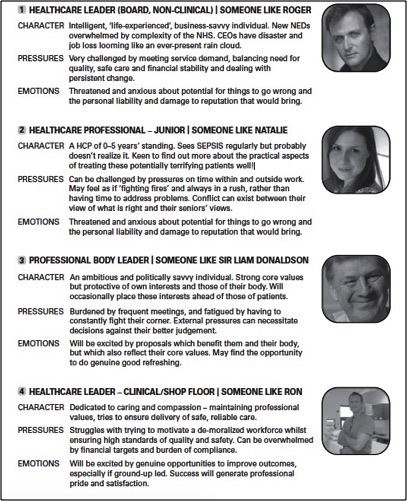To build more relevant experiences you need to take a step back and consider the context your brand and the associated experiences will be built within. In Building brand Experiences: A Practical Guide to Retaining Brand Relevance this context is called The Brand Experience Environment and comprises of four elements:
- Understanding your stakeholders
- Fine-tuning your perspective
- Considering the mechanics of delivery
- Adopting a data-driven approach
A closer look at each will help you build more relevant brand experiences.
1. Understanding Your Stakeholders
Profiling stakeholders: Empathy is insightful and provides a solid foundation for building relevant brand experiences. Profiling key stakeholders keeps them center stage and provides a powerful platform for building relevant brand experiences.

Helping stakeholders get ‘jobs done’: A ‘jobs to be done’ approach will focus your mind on building brand experiences that help stakeholders achieve goals or solve specific problems (for more detail on jobs to be done thinking read Prof Clayton Christensen and Steve Wunker’s work). The launch of Pfizer’s rheumatoid arthritis pill, Xeljanz, focused on helping customers get a specific job done: to enjoy moments that people without chronic pain don’t even think about. These include swimming, yoga or even standing on tiptoes to give their partner a hug. Such scenarios were incorporated into Xeljanz’s launch campaign that increased brand awareness by 24%, brand recall by 25% and prescription volumes by 95%.
Encouraging stakeholder engagement: The days of focusing on customers and talking at them have long gone. Relevant brands engage with stakeholders via the experiences they build. Mondelez encourages Oreo fans to showcase their dunking prowess via #OREODunkSweepstakes. Sime Darby’s Young Innovators Challenge engages the Millennial generation through innovation and the sustainability agenda. As part of the Virgin Active Australia rebrand launch, the Virgin Active team were invited to a special unveiling event to learn about the values, what they meant to them before getting down to a 30-minute DJ-led yoga experience. This shows how brand engagement goes far beyond customers now.
Managing stakeholder expectations: It’s common for brands to promise the universe but deliver far less. This is tantamount to brand experience suicide. Some time ago we were was asked to complete an annual report for a big bank and we needed to obtain their brand guidelines in addition to other marketing materials by mail. Usually this wouldn’t pose a problem but the client’s country was experiencing serious civil unrest. A DHL courier was in our reception three days later. I told him I was delighted to see the parcel arrive, not to mention so quickly. His response was ‘We under-promise and over-deliver.’ For an organization of DHL’s size to deliver a brand experience in this way is a testament to their internal communications and employee engagement efforts. I’ve lost track of how many times I’ve shared that story.
Familiarizing yourself with your stakeholders, not just customers, is an important part of the Brand Experience Environment. Once you know who your stakeholders are, where they go, what ‘jobs’ they need to get done, how you can engage with them and are realistic about what you can deliver, you’ll be well placed to build experiences that are more relevant to them.
2. Fine-Tuning Your Perspective
Embracing transparency: Stakeholders, especially the Millennial ‘generation’, are increasingly drawn to brands based on who they are, what they stand for and why they exist. This trend looks set to intensify with the advent of ‘Generation’ Z who expect brands to conduct their affairs in an open and transparent way. Patagonia’s Footprint Chronicles show the textile mills and factories it works with around the world while Unilever invites children to farms to learn what goes into Hellmann’s mayonnaise. Being able to stand up to this kind of stakeholder scrutiny is key.
Adopting a holistic mindset: Building brand experiences is everyone’s job. Research conducted by IBM shows that most sophisticated brands adopt a cross-functional approach to building brand experiences. It’s unlikely human resources, operations, facilities or customer services think building brand experiences is part of their job. Nothing could be further from the truth. When building brand experiences be prepared to cast a wide net.
Competing primarily through value not price: Between autumn 2009 and early spring 2014, we experienced the worst recession since the 1930s. Tough times teach valuable brand lessons. Ryanair’s cost-cutting exercises lost them customers and led to the company issuing two profit warnings in 2013. At the other end of the spectrum, between September 2009 and January 2014, Apple’s stock value soared from US $25 to $77. These examples show that even in austere times customers make buying decisions based on factors other than price.
Having patience: A glance at the Millward Brown BrandZ list shows the world’s most valuable brands are the result of years, if not decades, of hard graft. IBM, Coca Cola, AT&T, Visa and McDonald’s illustrate this point. Google, Facebook and Amazon have grown astronomically in a short time but they are the exception, not the norm. The cold truth is that building a brand and the associated experiences takes time. It takes time for your brand values to resonate with stakeholders. It takes time for brand positioning to fuse associations in memory. The experiences that bring your brand to life also need time due to the structural and cultural changes that may be required. Time is a luxury most CMO’s don’t have but there are ample case studies, when combined with a data-driven approach, which will catch even the most skeptical CEO’s eye. The key is to manage expectations and not to expect overnight miracles when building brand experiences.
Accepting a loss of control: Executives who think they control the brand experiences they build are mistaken. Burberry can do little to stop soccer hooligans from covering their faces with Burberry scarves when running riot. Many moons ago Burberry’ could control brand communications using magazines, newspapers, radio or TV. Then social media came along. Boom. Everything changed. Brand messages can now be modified or even distorted at frightening speed. Executives need to embrace this change and accept less control, but not relinquish it entirely. Nestle’s Data Acceleration Team (DAT) monitors real time data feeds so they can guide conversations in ways that are more on-brand. Google’s YouTube Labs works with social influencers to shape brand perceptions for the likes of L’Oreal and BMW. You have to let go – to some extent – or you’ll be building brand experiences for a bygone era.
When building brand experiences it’s important to fine-tune your perspective. This entails embracing transparency, adopting a holistic mindset, competing primarily through value, having patience and accepting a loss of control. Keep these in mind and you’ll be on track to build more relevant brand experiences.
3. Considering The Mechanics Of Delivery
Creating an emotional connection: The decisions humans make are primarily influenced by the emotions we feel that are associated with a memory. So if your brand carry’s no emotion it’s not playing a tune the human brain will be receptive to. Research shows the positive influence emotional rather than rational content has on brand favorability while another study showed the profitability of ads with purely emotional content was approximately twice those with only rational content. Emotion also plays a powerful role in B2B markets with IBM, GE and Caterpillar leading the way. B2B markets are characterized by complex, high-risk, high-value and long-term investments. This means experiences that mitigate risk, provide security, reassure, give peace of mind and enhance personal or organizational reputation are relevant. Irrespective of the market you operate in you need to understand how you want to make your stakeholders feel then build experiences that help you do that.
Facilitating co-creation: Empowerment and autonomy give brands appeal. One study showed that 54% of 18–34-year-olds feel having the opportunity to personalize products influences brand loyalty. Porsche Exclusive lets customers personalize their car while Shinola’s #LoveMyCity challenges local influencers to make a city guide they publish digitally. These world-class brands understand the need to delegate responsibility for building brand experiences because it engenders a sense of control. This is powerful because it’s liberating and taps into the human desire to feel useful. Co-creation also pushes some of the cost of producing the experience onto the customer.
Delivering omnichannel experiences: Customers know brands analyze vast amounts of data to understand their lifestyles, interests and purchase habits. In return they expect brands to deliver increasingly personalized experiences where, when and how they want. In Sephora stores customers can attend an online make-up tutorial at a ‘Beauty Workshop’ while pure-play digital brands like Amazon are moving into the physical retail space. The experiences you build need to unify mobile, tablet, desktop, retail or more so customers can glide between in and between channels a single, seamless sweep. That’s the expectation.
To build relevant brand experiences you need to consider the mechanics of brand experience delivery. This entails thinking about emotion, co-creation and omni-channel experiences. Doing so will encourage you to think about important details associated with building brand experiences.
4. Adopting A Data-Driven Approach
Obtaining robust (quantitative and qualitative) insights: Insight, not anecdote, needs to drive the brand experience building decisions you make. The perceived objectivity of numbers means they tend to talk in the boardroom but informed executives obtain qualitative and quantitative insights to shape the experiences they build. This compensates for each approach’s weaknesses, provides a more rounded perspective and robust results, as you’ll be embracing multiple prongs of attack.
Measuring holistically: Brands tend to focus on financial metrics because money talks in the boardroom. Understandable but not always advisable. Financial metrics are retrospective, have short-term horizons and account for only part of the brand experience measurement puzzle. It’s better to adopt a holistic approach to measuring brand experiences that spans employee, brand and financial metrics. Research shows employee and brand metrics drive financial performance so measuring all three delivers powerful cause-and-effect insights. The lag effect associated with employee and brand measures also means they act as a metaphorical crystal ball giving you time to take pre-emptive action before financial metrics slide.
Summing Up
Before you dive into building brand experiences you need to consider the context your brand and the associated experiences will be built within so you build more relevant experiences. Taking time to understand your stakeholders, fine-tune your perspective, consider the mechanics of delivery and adopt a data-driven approach will go a long way in helping you do this.
Contributed to Branding Strategy Insider by: Darren Coleman, excerpted from his new book Building Brand Experiences ©2018 with permission from Kogan Page Ltd.
The Blake Project Can Help You Create A Brighter Competitive Future In The Jobs To Be Done Workshop
Branding Strategy Insider is a service of The Blake Project: A strategic brand consultancy specializing in Brand Research, Brand Strategy, Brand Growth and Brand Education




